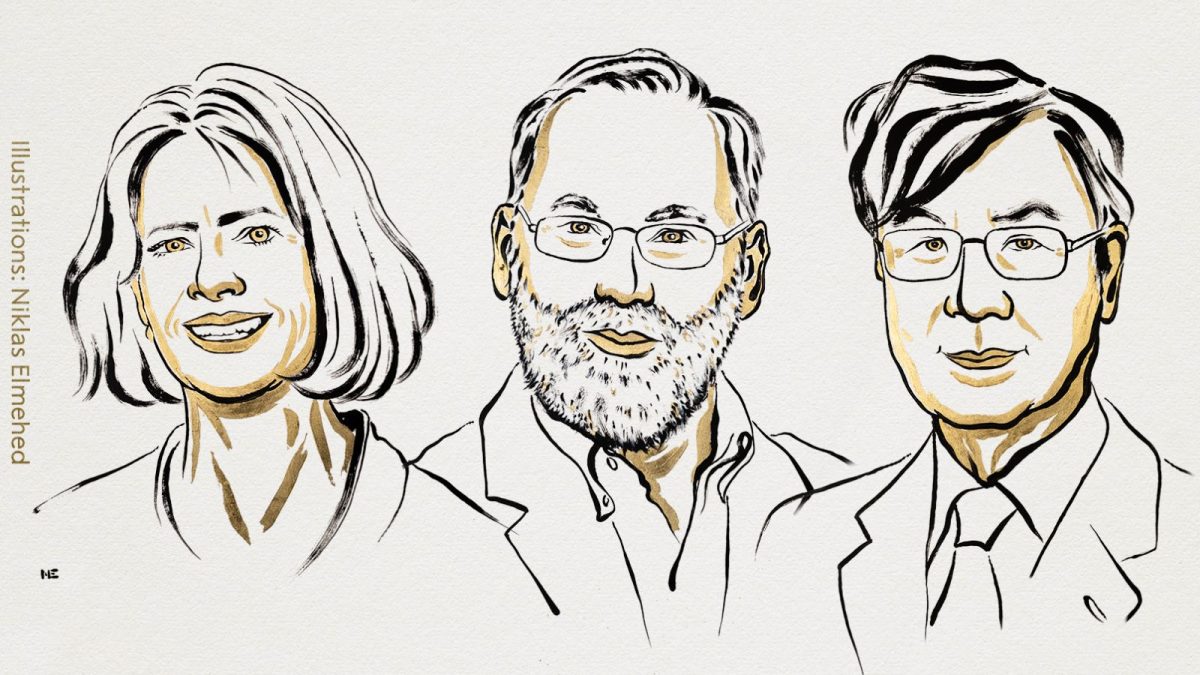Last Updated:
Nobel Prize in Physiology or Medicine 2025: Mary Brunkow, Fred Ramsdell and Shimon Sakaguchi provided fundamental knowledge of how the immune system is regulated and kept in check

(From left) Mary Brunkow, Fred Ramsdell and Shimon Sakaguchi. (X/Nobel Prize)
Mary E. Brunkow, Fred Ramsdell and Shimon Sakaguchi have won the Nobel Prize in Physiology or Medicine 2025 for their groundbreaking discoveries concerning peripheral immune tolerance that prevents the immune system from harming the body.
The prize-awarding body said that their discoveries laid the foundation for a new field of research and spurred the development of new treatments, for example for cancer and autoimmune diseases.
Recommended Stories
The nobelprize.org website explained the concept and the contribution of the three scientists. Edited excerpts from the report.
The immune system
The immune system protects humans from thousands of different viruses, bacteria and other microbes that attempt to invade our bodies. One of the immune system’s marvels is its ability to identify pathogens and differentiate them from the body’s own cells. So how does the immune system keep track of what to attack and what to protect? Why doesn’t the immune system attack our bodies more frequently?
The Nobel Prize Laureates identified the immune system’s security guards, regulatory T cells, thus laying the foundation for a new field of research. The discoveries have also led to the development of potential medical treatments that are now being evaluated in clinical trials.
BREAKING NEWSThe 2025 #NobelPrize in Physiology or Medicine has been awarded to Mary E. Brunkow, Fred Ramsdell and Shimon Sakaguchi “for their discoveries concerning peripheral immune tolerance.” pic.twitter.com/nhjxJSoZEr— The Nobel Prize (@NobelPrize) October 6, 2025
What are T cells? What is central tolerance?
Helper T cells constantly patrol the body. If they discover an invading microbe, they alert other immune cells, which then mount an attack. Killer T cells eradicate cells which have been infected by a virus or other pathogens. They can also attack tumour cells.
All T cells have special proteins called T-cell receptors on their surface. These receptors can be likened to a type of sensor. The vast number of T cells with different receptors ensures that there are always some that can detect the shape of an invading microbe, including new viruses, such as the one that started the COVID-19 pandemic in 2019. However, the body inevitably also creates T-cell receptors that can attach to parts of the body’s own tissues. So, what makes the T cells react to hostile microbes but not our own cells?
Here comes the central tolerance.
In the 1980s, researchers understood that when T cells mature in the thymus, they undergo a type of test that eliminates the T cells that recognise the body’s own – endogenous – proteins. This selection process is called central tolerance. In addition to this, some researchers suspected the existence of a type of cell that they called suppressor T cells. They believed that these dealt with T cells that had slipped through the test in the thymus. When it became apparent that some of the evidence for suppressor T cells was false, researchers rejected the entire hypothesis.
Regulatory T cells: What was Shimon Sakaguchi’s discovery?
Shimon Sakaguchi, who worked at the Aichi Cancer Center Research Institute in Nagoya, Japan, swam against the tide.
At the start of the 1980s, Sakaguchi isolated T cells that had matured in genetically identical mice and injected them into the mice without a thymus. This had an interesting effect: there appeared to be T cells that could protect the mice from autoimmune diseases.
This and other similar results convinced Sakaguchi that the immune system must have some form of security guard, one that calms down other T cells and keeps them in check. But what type of cell was this?
When researchers differentiate between T cells, they use proteins located on the cells’ surface. Helper T cells can be recognised thanks to a protein called CD4, while killer T cells are distinguished by CD8. In the experiment in which Sakaguchi protected the mice from autoimmune diseases, he used cells with CD4 on their surface – helper T cells. Ordinarily, these cells wake up the immune system and set it to work, but in Sakaguchi’s experiment the immune system was held back. His conclusion was that there must be different forms of T cells that carry CD4. To test his hypothesis, Sakaguchi needed to find a way of differentiating between the various types of T cell. This took him over a decade, but in 1995 he presented an entirely new class of T cells to the world. In The Journal of Immunology he demonstrated that these T cells – which calm the immune system – are characterised not only by carrying CD4 on their surface, but also a protein called CD25.
This newly identified T cell class was named regulatory T cells. However, many researchers were sceptical about its existence; they wanted more proof before they would believe in Sakaguchi’s discovery.
The mutation: Scurfy and the evolutionary fluke
In a laboratory, located in Oak Ridge, Tennessee, researchers were studying the consequences of radiation. Their work was part of the Manhattan Project and the development of the atomic bomb. The mouse strain that plays a vital role in this year’s Nobel Prize was an evolutionary fluke – some male mice were unexpectedly born with scaley and flaky skin, an extremely enlarged spleen and lymph glands, and they lived for just a few weeks. The mouse strain – which was given the name scurfy – captured the researchers’ attention.
Molecular genetics was in its infancy, but they realised that the mutation that caused this disease must be located on the mice’s X chromosome. Half of all the male mice are diseased, but the females can live with this mutation because they have two X chromosomes, of which one has healthy DNA. The female mice thus pass on the scurfy mutation to new generations. In the 1990s – when molecular tools had become considerably sharper – researchers began to investigate why the male scurfy mice got so ill. It turned out that their organs were being attacked by T cells that destroyed the tissues. For some reason, the scurfy mutation appeared to cause a rebellion in the immune system.
Brunkow and Ramsdell looked for explanation for autoimmune diseases
Two of the researchers who became interested in the scurfy mutation were Mary Brunkow and Fred Ramsdell. They worked at a biotech company, Celltech Chiroscience, in Bothell, Washington, US. The company developed pharmaceuticals for autoimmune diseases, and Brunkow and Ramsdell realised that the scurfy mice could provide them with important clues in their work.
Today, it is possible to map a mouse’s entire genome and find a mutated gene in a few days. In the 1990s, it was like looking for a needle in a gigantic haystack.
Mapping had shown that the scurfy mutation must be somewhere in the middle of the X chromosome. Brunkow and Ramsdell succeeded in narrowing down the potential area to around 500,000 nucleotides. Then they took on the enormous work of mapping that area of the X chromosome in detail.
When Brunkow and Ramsdell finished, they had established that the area contained 20 potential genes. Their next challenge was to compare these genes in healthy mice and scurfy mice. They examined gene after gene. It was only with the twentieth and final gene that they could shout bingo. After years of dedicated work, they had finally found the scurfy mutation.
The faulty gene was previously unknown, but had many similarities with a group of genes called forkhead box or FOX genes. These regulate the activity of other genes, which can affect cell development. Mary Brunkow and Fred Ramsdell named the new gene Foxp3.
During their work, Brunkow and Ramsdell had begun to suspect that a rare autoimmune disease, IPEX, which is also linked to the X chromosome, might be the human variant of the scurfy mice’s disease. On searching a database where researchers store information on newly discovered genes, they found the human equivalent of Foxp3. Helped by paediatricians from around the world, they collected samples from boys affected by IPEX. When they mapped the samples, they did indeed find harmful mutations in the FOXP3 gene.
In 2001, in Nature Genetics, Mary Brunkow and Fred Ramsdell revealed that mutations in the FOXP3 gene cause both the human disease called IPEX and the scurfy mice’s ill health. These key findings led to febrile activity in several laboratories. When researchers pieced the puzzle together, they understood that the FOXP3 gene could be important for the regulatory T cells discovered by Sakaguchi.
Two years later, Shimon Sakaguchi – and soon other researchers – could convincingly prove that the FOXP3 gene controls the development of regulatory T cells. These cells prevent other T cells from mistakenly attacking the body’s own tissue, which is important for a process called peripheral immune tolerance. Regulatory T cells also ensure the immune system calms down after it has eliminated an invader, so it does not continue working at top speed.
Through their revolutionary discoveries, Mary Brunkow, Fred Ramsdell and Shimon Sakaguchi have provided fundamental knowledge of how the immune system is regulated and kept in check. They have thus conferred the greatest benefit to humankind, said the report.
About the Author
The News Desk is a team of passionate editors and writers who break and analyse the most important events unfolding in India and abroad. From live updates to exclusive reports to in-depth explainers, the Desk d…Read More
The News Desk is a team of passionate editors and writers who break and analyse the most important events unfolding in India and abroad. From live updates to exclusive reports to in-depth explainers, the Desk d… Read More
October 06, 2025, 16:38 IST
Loading comments…
Read More







